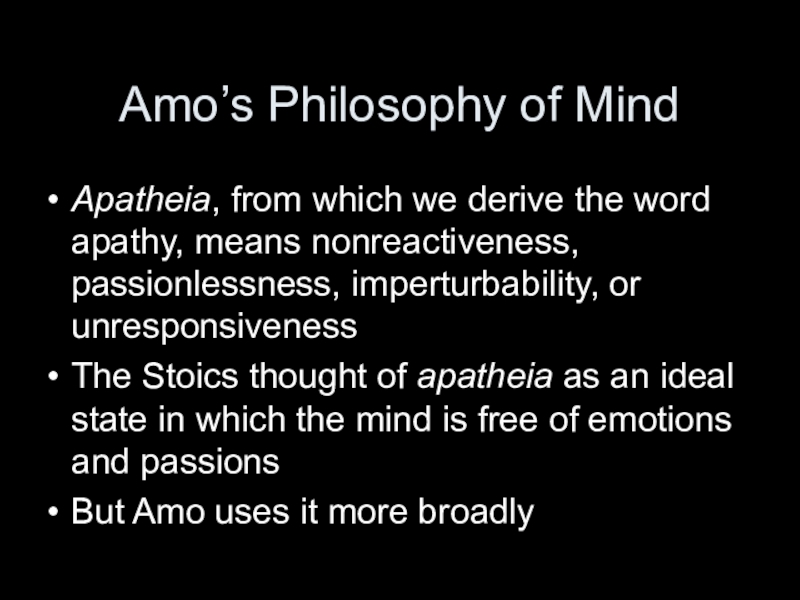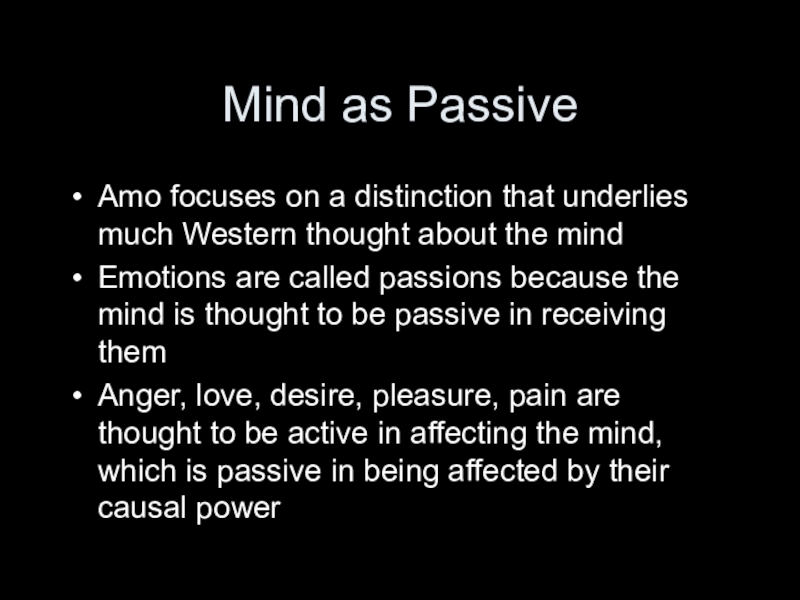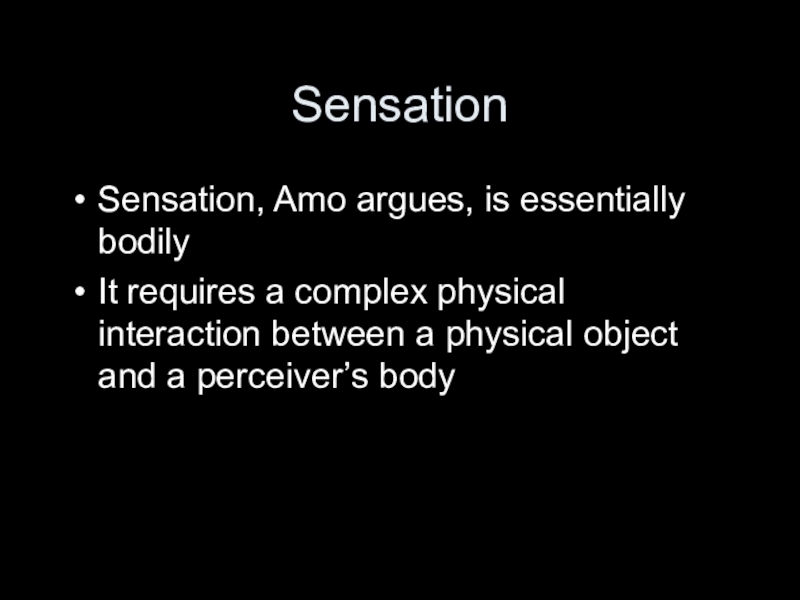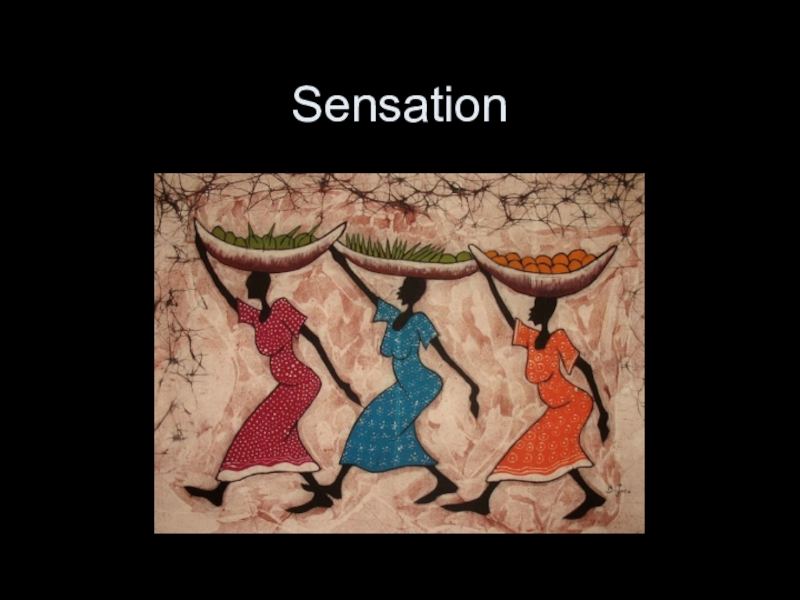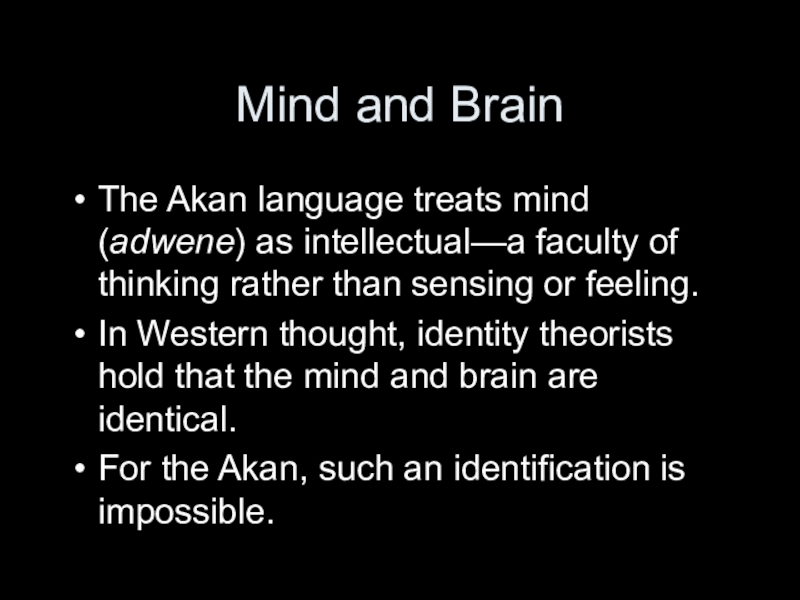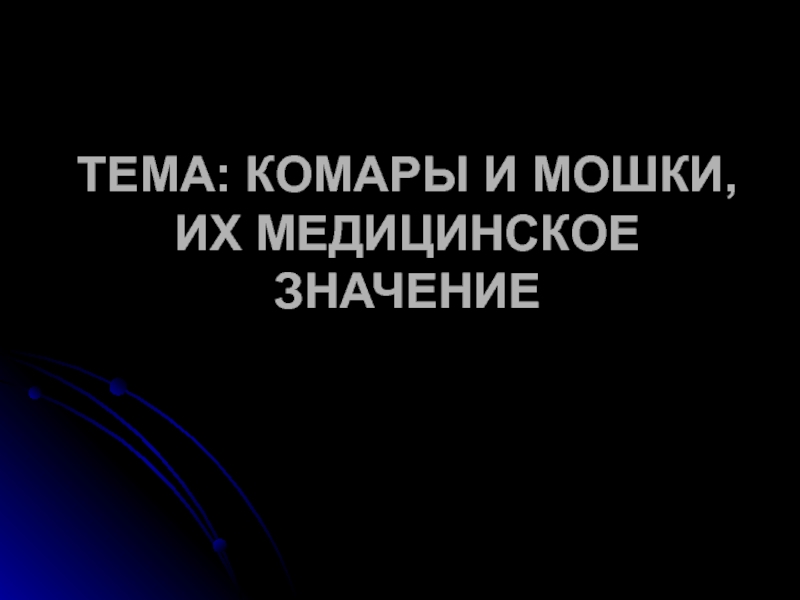Разделы презентаций
- Разное
- Английский язык
- Астрономия
- Алгебра
- Биология
- География
- Геометрия
- Детские презентации
- Информатика
- История
- Литература
- Математика
- Медицина
- Менеджмент
- Музыка
- МХК
- Немецкий язык
- ОБЖ
- Обществознание
- Окружающий мир
- Педагогика
- Русский язык
- Технология
- Физика
- Философия
- Химия
- Шаблоны, картинки для презентаций
- Экология
- Экономика
- Юриспруденция
Psychology and Philosophy of Mind
Содержание
- 1. Psychology and Philosophy of Mind
- 2. Anton Wilhelm Amo
- 3. Amo’s Philosophy of MindAnton Wilhelm Amo (1703-1759?),
- 4. Amo’s Philosophy of MindApatheia, from which we
- 5. Mind as PassiveAmo focuses on a distinction
- 6. SensationSensation, traditionally, is thought to be similar
- 7. SensationSensation, Amo argues, is essentially bodily It
- 8. Sensation
- 9. The MindBut how does interaction between object
- 10. Amo’s ParadoxThe mind as spiritual substance is
- 11. IdeasFor Descartes, the gap between sensation and
- 12. Two RolesBut Descartes is assigning ideas two
- 13. Two RolesAmo argues that a spiritual substance
- 14. A Thing that Thinks—and SensesWe are not
- 15. Mind and BrainThe Akan language treats mind
- 16. MindThe mind is a “permanent possibility of
- 17. Basis of the MindFor the Akan, the
- 18. Mind and PersonA person consists of body,
- 19. Mind and BodyThis dissolves the mind/body problemSince
- 20. DualitiesWestern philosophers often split the self into
- 21. CreativityThe distinction between male and female provides
- 22. CreativityHuman beings are thus essentially creative Our
- 23. FreedomOur creative essence rests on our freedom
- 24. FreedomOur creative essence also rests on our
- 25. “A Thing that Acts”Descartes writes, “What am
- 26. “A Thing that Acts”
- 27. Personal IdentityPhilosophers of mind ask not only
- 28. Personal IdentityAm I really the same person
- 29. Mind/Body/IdentityThese questions are closely related If I
- 30. Divided SelfThe Yoruba, like many west African
- 31. Thought ExperimentsIf Jones’s brain (or mind) is
- 32. Thought ExperimentsJones? Smith?The Yoruba want to know
- 33. PersonalityI am a being consisting of body
- 34. Скачать презентанцию
Anton Wilhelm Amo
Слайды и текст этой презентации
Слайд 3Amo’s Philosophy of Mind
Anton Wilhelm Amo (1703-1759?), a native of
Ghana, became the first black professor in Germany
the Human Mind: a critique of Descartes’s dualismСлайд 4Amo’s Philosophy of Mind
Apatheia, from which we derive the word
apathy, means nonreactiveness, passionlessness, imperturbability, or unresponsiveness
The Stoics thought
of apatheia as an ideal state in which the mind is free of emotions and passionsBut Amo uses it more broadly
Слайд 5Mind as Passive
Amo focuses on a distinction that underlies much
Western thought about the mind
Emotions are called passions because
the mind is thought to be passive in receiving them Anger, love, desire, pleasure, pain are thought to be active in affecting the mind, which is passive in being affected by their causal power
Слайд 6Sensation
Sensation, traditionally, is thought to be similar to passion
The
mind passively receives sensory impressions from the world
Notice the imagery:
The world makes impressions on the mind much as a seal might make an impression on hot waxThe mind is active, on this picture, only when it exercises reason
Слайд 7Sensation
Sensation, Amo argues, is essentially bodily
It requires a complex
physical interaction between a physical object and a perceiver’s body
Слайд 9The Mind
But how does interaction between object and body have
any effect on the mind?
Amo grants the Cartesian assumption
that the mind is a spiritual substance But a spiritual substance, he insists, is purely active and immaterial
It always gains understanding through itself (i.e., directly), and acts from self-motion and with intention in regard to an end and goal of which it is conscious to itself
Слайд 10Amo’s Paradox
The mind as spiritual substance is purely active
Anything receiving
sensations is in so doing purely passive
Слайд 11Ideas
For Descartes, the gap between sensation and reason is filled
with ideas; indeed, Descartes’s contribution to early modern philosophy is
often summarized as “the new way of ideas.”Слайд 12Two Roles
But Descartes is assigning ideas two different and, in
Amo’s eyes, incompatible roles
There is a difference between Jones’s
thinking ‘There’s a table’ and seeing the tableСлайд 13Two Roles
Amo argues that a spiritual substance could think, but
not see, hear, or feel
The actual sensing must be
materialThe faculty of sensation is not mental but physical
Слайд 14A Thing that Thinks—and Senses
We are not essentially things that
think, as Descartes declares, and only inessentially bodies
We are
essentially both A person is essentially a thinking being, but also essentially a sensing being, and therefore essentially embodied
Слайд 15Mind and Brain
The Akan language treats mind (adwene) as intellectual—a
faculty of thinking rather than sensing or feeling.
In Western
thought, identity theorists hold that the mind and brain are identical. For the Akan, such an identification is impossible.
Слайд 16Mind
The mind is a “permanent possibility of thought,” which is
not an object at all
The mind consists of thoughts,
but it is not simply a bundle of thoughtsIt is a certain kind of capacity, a capacity to have thoughts
Слайд 17Basis of the Mind
For the Akan, the brain is the
basis of the mind
It is by having a brain that
I have the capacity for thoughtСлайд 18Mind and Person
A person consists of body, life-force, and personality
The mind is not a constituent of a person, for
the simple reason that it is not a thing The mind is not a component of a person for the same reason that moving is not a part of a car
Слайд 19Mind and Body
This dissolves the mind/body problem
Since the mind is
not a thing, the question of how it can relate
to a material thing, the body, does not ariseСлайд 20Dualities
Western philosophers often split the self into
mind and body,
or
spirit and flesh, or
reason and desire
The dual elements
are complementary but also conflicting Reconciling and unifying them is the central human task
Слайд 21Creativity
The distinction between male and female provides a model for
this kind of duality
The union of male and female
brings about creation So, too, is the union of dual elements a fundamentally creative process
Слайд 22Creativity
Human beings are thus essentially creative
Our central obligation is
to create
We create things
We create a personality through our actions
Together we create a social order
In each case, we must reconcile and unite conflicting elements, synthesizing them into an organic whole
Слайд 23Freedom
Our creative essence rests on our freedom
The conflicting forces
we must unite do not control or determine us
We
are self-determining; we are free to reconcile conflicting elements as we please, creating, in the process, our own distinctive personalities and livesСлайд 24Freedom
Our creative essence also rests on our choosing among possibilities
Possibilities, potentialities, are thus central to who we are
Finally,
our creative essence implies that we are also essentially agents We make choices and act, changing the world and ourselves as we do
Слайд 25“A Thing that Acts”
Descartes writes, “What am I? A thing
that thinks.”
For the Akan, it would be more accurate to
say, “What am I? A thing that acts.” I am a thing that confronts and realizes possibilities, makes choices, reconciles conflicts, and creates things, including myself
Слайд 27Personal Identity
Philosophers of mind ask not only
“What am I?”
and
“What makes me human?” but also
“What makes me
me?”What makes me the person I am?
Слайд 28Personal Identity
Am I really the same person I was as
a baby or a small child?
Will I be the
same person when I am old? If so, what explains that?
What makes me the same person throughout the entire course of my life?
Слайд 29Mind/Body/Identity
These questions are closely related
If I am essentially mind
or consciousness, I will tend to look to mind or
consciousness to explain my continuing identityIf I am essentially a physical being, I will tend to look for physical explanations of my continuity
Conversely, if I can explain my identity in certain terms, that will suggest that my essence can be understood in those same terms
Слайд 30Divided Self
The Yoruba, like many west African tribes, divide the
self into three components:
the body,
the mind (or soul,
or consciousness), and the ori, the “inner head” or personality
Слайд 31Thought Experiments
If Jones’s brain (or mind) is transplanted into Smith’s
body, is the resulting person Smith or Jones?
Слайд 32Thought Experiments
Jones?
Smith?
The Yoruba want to know how the resulting
being acts
Does it act like Jones or like Smith?
The Yoruba see this as a question about ori. Does this person have Smith’s ori or Jones’s?
Слайд 33Personality
I am a being consisting of body and mind and
personality
What is essential to my identity is my ori, my
personality That is what makes me me
Anything that radically changed my personality would disrupt my identity, even if it did not disrupt body or consciousness



